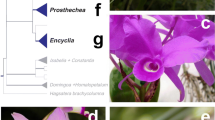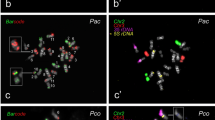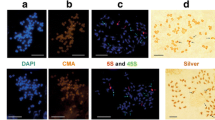Abstract
The genus Cephalanthera is an excellent plant group for karyotype evolution studies because it exhibits a dysploid series and bimodal karyotypes. With the aim of understanding their chromosomal and phylogenetic relationships, rRNA genes and the Arabidopsis-type telomeric sequence were mapped by fluorescence in-situ hybridization (FISH), and the rDNA intergenic spacer (ITS) was sequenced for the first time in three European species: C. longifolia (2n = 4x = 32), C. damasonium (2n = 4x = 36) and C. rubra (2n = 4x = 44). One 45S and three 5S rDNA sites are observed in C. longifolia, one 45S and two 5S sites in C. damasonium, and two 45S and one 5S site in C. rubra. Telomeric signals were observed at every chromosome end in all three species and C. damasonium also displays interstitial signals on three chromosome pairs. In agreement with chromosome data, molecular analyses support C. longifolia and C. damasonium as closely related taxa, while C. rubra stands apart. Possible pathways of karyotype evolution are discussed in reference to a previous hypothesis. The results indicate that complex chromosomal rearrangements, possibly involving Robertsonian fusions and fissions, loss of telomeric repeats, gain or loss of rDNA sites and other heterochromatic sequences and inversions, may have contributed to generating the present-day karyotypes.
Similar content being viewed by others
References
Adams SP, Leitch IJ, Bennett MD, Chase MW, Leitch AR (2000) Ribosomal DNA evolution and phylogeny in Aloe (Asphodelaceae). Am J Bot 87: 1578–1583.
Azzalin CM, Nergadze SG, Giulotto E (2001) Human intrachromosomal telomeric-like repeats: sequence organization and mechanisms of origin. Chromosoma 110: 75–82.
Baldwin BG, Sanderson MJ, Porter JM, Wojciechowski MF, Campell CS, Donoghue MJ (1995) The ITS region of nuclear ribosomal DNA: a valuable source of evidence on angiosperm phylogeny. Ann Missouri Bot Gard 82: 247–277.
Bateman RM, Hollingsworth PM, Preston J, Yi-Bo L, Pridgeon AM, Chase MW (2003) Molecular phylogenetics and evolution of Orchidinae and selected Habenariinae (Orchidaceae). Bot J Linn Soc 142: 1–40.
Bennett MD, Leitch IJ (1995) Nuclear DNA amounts in angiosperms. Ann Bot 76: 113–176.
Cai Q, Zhang D, Liu Z-L, Wang X-R (2006) Chromosomal localization of 5S and 18S rDNA in five species of subgenus Strobus and their implications for genome evolution of Pinus. Ann Bot 97: 715–722.
Cameron KM (2004) Utility of plastid psaB gene sequences for investigating intrafamilial relationships within Orchidaceae. Mol Phyl Evol 31: 1157–1180.
Cameron KM, Chase MW, Whitten WM et al. (1999) A phylogenetic analysis of the Orchidaceae: evidence from rbcL nucleotide sequences. Am J Bot 86: 208–224.
Cox AV, Bennett ST, Parokonny AS, Kenton A, Callimassia MA, Bennett MD (1993) Comparison of plant telomere locations using a PCR-generated synthetic probe. Ann Bot 72: 239–247.
Cox AV, Pridgeon AM, Albert VA, Chase MW (1997) Phylogenetics of the slipper orchids (Cypripedioideae, Orchidaceae): nuclear rDNA ITS sequences. Plant Syst Evol 208: 197–223.
Cox AV, Abdelnour GJ, Bennett MD, Leitch IJ (1998) Genome size and karyotype evolution in the slipper orchids (Cypripedioideae: Orchidaceae). Am J Bot 85: 681–687.
D’Emerico S, Grünanger P, Scrugli A, Pignone D (1999) Karyomorphological parameters and C-bands distribution suggest phyletic relationship within the subtribe Limodorinae Bentham (Orchidaceae). Plant Syst Evol 217: 147–161.
D’Emerico S, Pignone D, Scrugli A (2000) Karyomorphology and evolution in Italian populations of three Neottieae species (Orchidaceae). Cytologia 65: 189–195.
Doyle JJ, Doyle JL (1987) A rapid DNA isolation procedure for small quantities of fresh leaf tissue. Phytochem Bull 19: 11–15.
Dressler RL (1993) Phylogeny and Classification of the Orchid Family. Portland: Dioscorides Press.
Dressler RL, Chase MW (1995) Whence the orchids? In: Rudall PJ, Cribb PJ, Cutler DF, Humphries CJ, eds. Monocotyledons: Systematics and Evolution, vol. I. Kew: Royal Botanic Gardens, pp. 217–226.
Fedorov A, ed. (1969) Chromosome Numbers of Flowering Plants. Reprinted 1974. Koeningstein: O Koeltz Sci Publ.
Felsenstein J (1985) Confidence limits of phylogenies: an approach using bootstrap. Evolution 39: 783–791.
Freudenstein JV, Rasmussen FN (1999) What does morphology tell us about orchid relationships?–A cladistic analysis. Am J Bot 86: 225–248.
Fuchs J, Brandes A, Schubert I (1995) Telomere sequence localization and karyotype evolution in higher plants. Plant Syst Evol 196: 227–241.
Goldblatt P, ed. (1985) Index to plant chromosome numbers 1982–1983. Monogr Syst Bot Missouri Bot Gard 13: 135.
Greilhuber J, Speta F (1976) C-banded karyotypes in the Scilla hohenackeri group, S. persica, and Puschkinia (Liliaceae). Plant Syst Evol 126: 149–188.
Hasterok R, Wolny E, Hosiawa M et al. (2006) Comparative analysis of rDNA distribution in chromosomes of various species of Brassicaceae. Ann Bot 97: 205–216.
Heslop-Harrison JS, Schwarzacher T, Anamthawat-Jónsson K, Leitch AR, Shi M, Leitch IJ (1991) In situ hybridization with automated chromosome denaturation. Technique 3: 109–115.
Heslop-Harrison JS, Harrison GE, Leitch IJ (1992) Reprobing of DNA:DNA in situ hybridization preparations. Trends Genet 8: 372–373.
Higgins DG, Bleasby AJ, Fuchs R (1992) CLUSTAL: A new multiple sequence alignment program. Comp Appl Biosci 8: 189–191.
Ijdo JW, Wells RA, Baldini A, Reeders ST (1991) Improved telomere detection using a telomere repeat probe (TTAGGG) n generated by PCR. Nucleic Acids Res 19: 4780.
Jones K (1998) Robertsonian fusion and centric fission in karyotype evolution of higher plants. Bot Rev 64: 273–289.
Kliphuis E (1963) Cytological observations in relation to the taxonomy of the orchids of the Netherlands. Acta Bot Neerl 12: 172–194.
Kores PJ, Cameron KM, Molvray M, Chase MW (1997) The phylogenetic relationships of Orchidoideae and Spiranthoideae (Orchidaceae) as inferred from rbcL plastid sequences. Lindleyana 12: 1–11.
Lee C, Sasi R, Lin CC (1993) Interstitial localization of telomeric DNA sequences in the Indian muntjac chromosomes: further evidence for tandem chromosome fusions in the karyotypic evolution of the Asian muntjacs. Cytogenet Cell Genet 63: 156–159.
Lee WB, Kim YS (1986) A taxonomic study on genus Cephalanthera in Korea. Korean J Plant Taxon 16: 39–57.
Levan A, Fredga K, Sandberg AA (1964) Nomenclature for centromeric position on chromosomes. Hereditas 52: 201–220.
Liu Z-L, Zhang D, Hong D-Y, Wang X-R (2003) Chromosomal localization of 5S and 18S–5.8S–25S ribosomal DNA sites in five Asian pines using fluorescence in situ hybridization. Theor Appl Genet 106: 198–204.
Mehra PN, Kashyap SK (1983) Cytological studies in some west Himalayan orchids. Tribe: Neottieae. I. Sub-tribe: Limodorinae. Caryologia 36: 33–45.
Meili-Frei E (1966) Cytogenetik und Cytotaxonomie einheimischer Arten von Epipactis, Listera, Neottia (Orchidaceae). Ber Schweiz Bot Ges 75: 219–292.
Meyne J, Baker RJ, Hobart HH et al. (1990) Distribution of non-telomeric sites of the (TTAGGG) n telomeric sequence in vertebrate chromosomes. Chromosoma 99: 3–10.
Moore RJ, ed (1973) Index to plant chromosome numbers 1967–1971. Regnum Veg 90: 144.
Moscone EA, Maztke MA, Matzke AJM (1996) The use of combined FISH/GISH in conjunction with DAPI counterstaining to identify chromosomes containing transgene inserts in amphidiploid tobacco. Chromosoma 105: 231–236.
Moscone EA, Klein F, Lambrou M, Fuchs J, Schweizer D (1999) Quantitative karyotyping and dual-color FISH mapping of 5S and 18S-25S rDNA probes in the cultivated Phaseolus species (Leguminosae). Genome 42: 1224–1233.
Navratilova A, Neumann P, Macas J (2003) Karyotype analysis of four Vicia species using in-situ hybridization with repetitive sequences. Ann Bot 91: 921–926.
Pedrosa A, Jantsch MF, Moscone EA, Ambros PF, Schweizer D (2001) Characterisation of pericentromeric and sticky intercalary heterochromatin in Ornithogalum longibracteatum (Hyacinthaceae). Chromosoma 110: 203–213.
Pedrosa A, Sandal N, Stougaard J, Schweizer D, Bachmair A (2002) Chromosomal map of the model legume Lotus japonicus. Genetics 161: 1661–1672.
Pedrosa A, Vallejos CE, Bachmair A, Schweizer D (2003) Integration of common bean (Phaseolus vulgaris(L.)) linkage and chromosomal maps. Theor Appl Genet 106: 205–212.
Presting GG, Frary A, Pillen K, Tanksley SD (1996) Telomere-homologous sequences occur near the centromeres of many tomato chromosomes. Mol Gen Genet 251: 526–531.
Richards EJ, Goodman HM, Ausubel FM (1991) The centromere region of Arabidopsis thaliana chromosome 1 contains telomere-similar sequences. Nucleic Acids Res 19: 3351–3357.
Schlarbaum SE, Tsuchiya T (1984) The chromosomes of Cunninghamia konishii, C. lanceolata, and Taiwania cryptomerioides (Taxodiaceae). Plant Syst Evol 145: 169–181.
Schmidt T, Schwarzacher T, Heslop-Harrison JS (1994) Physical mapping of rRNA genes by fluorescent in situ hybridization and structural analysis of 5S rRNA genes and intergenic spacer sequences in sugar beet (Beta vulgaris). Theor Appl Genet 88: 629–636.
Schwarzacher T (1983) Karyotype and heterochromatin in Cephalanthera (Orchidaceae). In: Brandham PE, Bennett MD, eds. Kew Chromosome Conference II. London: George Allen & Unwin, pp 364.
Schwarzacher T (2003) DNA, chromosomes, and in-situ hybridization. Genome 46: 953–962.
Schwarzacher T, Schweizer D (1982) Karyotype analysis and heterochromatin differentiation with Giemsa C-banding and fluorescent counterstaining in Cephalanthera (Orchidaceae). Plant Syst Evol 141: 91–113.
Schwarzacher T, Ambros P, Schweizer D (1980) Application of Giemsa banding to orchid karyotype analysis. Plant Syst Evol 134: 293–297.
Shibata F, Hizume M (2002) Evolution of 5S rDNA units and their chromosomal localization in Allium cepa and Allium schoenoprasum revealed by microdissection and FISH. Theor Appl Genet 105: 167–172.
Shibata F, Matsusaki Y, Hizume M (2005) AT-rich sequences containing Arabidopsis-type telomere sequence and their chromosomal distribution in Pinus densiflora. Theor Appl Genet 110: 1253–1258.
Swofford DL (2002) Paup*: phylogenetic analysis using parsimony (*and other methods). Version 4.ob10. Sunderland, MA: Sinauer.
Taketa S, Ando H, Takeda K, Ichii M, Von Bothmer R (2005) Ancestry of American polyploid Hordeum species with the I genome inferred from 5S and 18S–25S rDNA. Ann Bot 96: 23–33.
Tanaka R, Yokota M (1982) Karyotype of Cephalanthera subaphylla, Orchidaceae. Chrom Inf Serv 33: 34–36.
Tek AL, Jiang J (2004) The centromeric regions of potato chromosomes contain megabase-sized tandem arrays of telomere-similar sequence. Chromosoma 113: 77–83.
Tutin TG, Heywood VH, Burges NA et al., eds. (1980) Flora Europaea, vol. 5, Alismataceae to Orchidaceae (Monocotyledones). Cambridge: Cambridge University Press.
Vaio M, Speranza P, Valls JF, Guerra M, Mazzella C (2005) Localization of the 5S and 45S DNA sites and cpDNA sequence analysis in species of the Quadrifaria group of Paspalum (Poaceae, Paniceae). Ann Bot 96: 191–200.
Walters SM, Brady A, Brickell CD et al., eds (1984) The European Garden Flora, vol. 2, Monocotyledons (part II). Cambridge: Cambridge University Press.
Wanzenböck E-M, Schöfer C, Schweizer D, Bachmair A (1997) Ribosomal transcription units integrated via T-DNA transformation associate with the nucleolus and do not require upstream repeat sequences for activity in Arabidopsis thaliana. Plant J 11: 1007–1016.
Zhang D, Sang T (1998) Chromosomal structural rearrangement of Paeonia brownii and P. californica revealed by fluorescence in situ hybridization. Genome 41: 848–853.
Author information
Authors and Affiliations
Corresponding author
Electronic Supplementary Material
Below is the link to the supplementary material.
Rights and permissions
About this article
Cite this article
Moscone, E.A., Samuel, R., Schwarzacher, T. et al. Complex rearrangements are involved in Cephalanthera (Orchidaceae) chromosome evolution. Chromosome Res 15, 931–943 (2007). https://doi.org/10.1007/s10577-007-1174-6
Received:
Revised:
Accepted:
Published:
Issue Date:
DOI: https://doi.org/10.1007/s10577-007-1174-6




